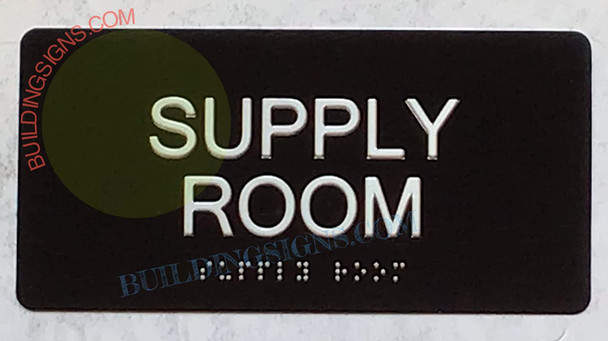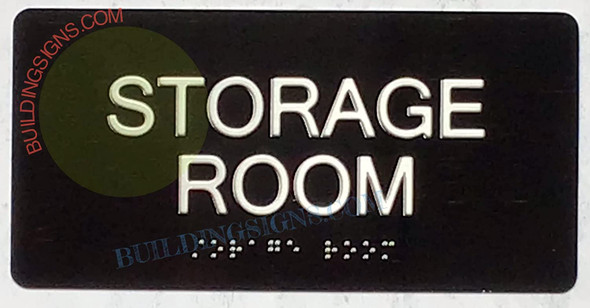BUILDINGSIGNS.COM
SUPPLY ROOM Sign Tactile Touch Braille Sign (Aluminum !!,black, Size 4x8)- The Sensation line
- SKU:
- B0BSXQFFHT
- UPC:
- 736816320406
- Availability:
- Usually Ship Within 2 days
Description
About this item
SUPPLY ROOM SIGN
RAISED LETTERS RAISED BRAILLE STRONG CONTRAST ALUMINIUM SIGN ( NOT A PLASTIC ) RUST FREE COMMERCIAL USE COMES WITH DOUBLE SIDED TAPE- EASY INSTALLTION DESIGNED TO LAST SIZE 4X8 INCH
The Importance of Braille "Supply Room" Signs in Buildings
In the mosaic of building accessibility, Braille signage plays a crucial role in ensuring equitable access and safety for individuals with visual impairments. Among the various types of Braille signage, the presence of "Supply Room" signs in Braille is particularly significant. These signs not only enhance navigation and safety but also promote inclusivity and independence within building environments.
Enhancing Accessibility and Navigation
Braille "Supply Room" signs are essential for providing clear and accessible information to individuals who are blind or have low vision. In buildings where storage rooms and supply areas are integral to operations, these signs help individuals identify and locate these spaces independently. This independence in navigation empowers individuals with visual impairments to move through buildings confidently, facilitating efficient access to necessary resources and materials.
Facilitating Safety and Efficiency
Safety considerations are paramount in building management, especially concerning access to supply rooms that may contain hazardous materials or equipment. Braille "Supply Room" signs contribute significantly to safety protocols by clearly identifying these areas. This clear identification helps prevent accidental entry into restricted or potentially dangerous spaces, ensuring the safety of all building occupants, including those with visual impairments.
Legal Compliance and Social Responsibility
The installation of Braille "Supply Room" signs also aligns with legal requirements and ethical responsibilities outlined in accessibility regulations such as the Americans with Disabilities Act (ADA). These regulations mandate that public and commercial buildings must provide accessible information and facilities for individuals with disabilities. By incorporating Braille signage, building owners and managers not only comply with these laws but also demonstrate a commitment to inclusivity and equal access for all individuals within their facilities.
Promoting Independence and Dignity
Beyond legal compliance, Braille "Supply Room" signs promote independence and dignity among individuals with visual impairments. Access to essential information through Braille empowers these individuals to navigate buildings autonomously, reducing their reliance on assistance from others. This independence fosters a sense of confidence and self-sufficiency, contributing to a more inclusive and respectful environment where all individuals can participate fully in daily activities and professional endeavors.
Educational and Cultural Significance
Moreover, the presence of Braille signage, including "Supply Room" signs, holds educational and cultural significance. Exposure to Braille in public spaces reinforces literacy skills among individuals who rely on tactile information for communication and learning. Additionally, recognizing Braille as a legitimate medium of communication promotes cultural acceptance and appreciation of diversity within society.
Advancements and Future Considerations
As technology and design continue to advance, there are opportunities to innovate Braille signage further. Enhanced tactile graphics and interactive signage systems can improve the functionality and usability of Braille "Supply Room" signs, ensuring they remain effective tools for communication and navigation in modern building environments.
In conclusion, the installation of Braille "Supply Room" signs in buildings is essential for fostering accessibility, safety, and inclusivity. By prioritizing clear communication, legal compliance, and the empowerment of individuals with visual impairments, these signs contribute to creating environments where everyone can navigate with independence and dignity. As we strive for universal accessibility, the integration of Braille signage represents a critical step toward building a more inclusive society that values and supports the diverse needs of all individuals.
DISCLAIMER to comply with the New York City Consumer Protection Law which applies to all businesses operating in New York City: We are small family-owned and family-operated Brooklyn-based business. We are not a City of New York store nor are the website, products or services affiliated with the City of New York or any agency of the City of New York. We ourselves, our business, websites, products, services, or any hyperlinks from its website are not sponsored by, approved by, affiliated with, endorsed by, or connected to the City of New York or any agency of the City of New York, including but not limited to HPD, DOB, DOT, DSNY, FDNY and federal directly or by implication. DISCLAIMER These codes may not be the most recent version. The State / federal or other regulation department may have more current or accurate information. We make no warranties or guarantees about the accuracy, completeness, or adequacy of the information contained on this site or the information linked to on the state site. Please check official sources. The requirements for sign content are determined by intended use and by applicable regulation. The BUYER is responsible for determining the appropriate content for a sign or package of signs. WE make no warranty or representation of suitability of a sign for any specific application. IT IS THE CUSTOMER'S RESPONSIBILITY TO ENSURE THAT THE SIGNS THE CUSTOMER ORDERS ARE IN COMPLIANCE WITH ALL STATE, FEDERAL, LOCAL, AND MUNICIPAL LAWS. Please review terms and conditions prior to purchase. For more information about what is required, see the laws that are referenced and the rules applicable to your city and state. This page is for informational purposes only and is not intended as legal advice, professional advice or a statement of law. You may wish to consult with an attorney.


























